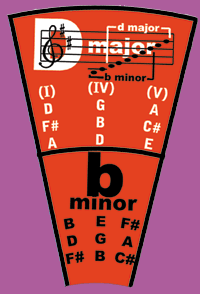Now look at the chord structure of the last measure. Can you find DF#A notes there? If not, take a look at the “ b ”minor chord in The Music Wheel slice. Do you see the notes that make up an “a”minor chord—BDF#?
Assuming the arrangement is using the grand staff (treble & bass), the chords can be written on the staff in any order. For instance, a D chord may have a D/A combo in the bass staff and an F#,D on the right hand. (When playing the Keyboard from a grand staff arrangement, the notes of the chord will normally be divided between the two hands.)
